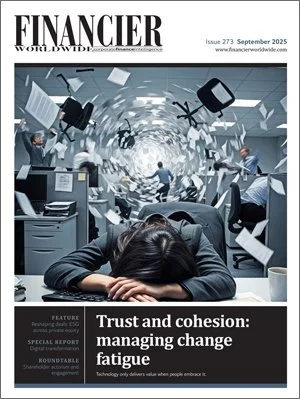Digital transformation as a strategic driver of online reputation
September 2025 | SPECIAL REPORT: DIGITAL TRANSFORMATION
Financier Worldwide Magazine
In today’s hyper-transparent, hyper-connected world, digital transformation is a reputational strategy. As markets evolve and stakeholder expectations rise, organisations must prioritise enhancing their image, online or otherwise, as part of their digital evolution.
A strong online presence impacts key business outcomes like customer acquisition, employee retention, investor confidence and long-term valuation. When digital transformation is aligned with reputation-building goals, it can provide a significant competitive advantage and deliver measurable financial gains.
Transformation now means demonstrating values, credibility and capability through digital assets. First impressions happen online, and what stakeholders see on an organisation’s platforms defines its reputation.
The opportunity to transform has never been greater. With rapid technological advancements, rising digital expectations and increased transparency, organisations can now redefine how they are seen and trusted online. Those that act decisively can lead, attract trust and build lasting reputational equity.
Defining digital reputation and trust signals
Digital reputation is a composite of how customers, employees, investors and the market perceive an organisation online. It includes the brand, leadership, data practices and communication. In the digital realm, the scope of reputation expands to incorporate other factors, such as feedback ratings, social media and online reviews, which serve as ‘trust signals’.
Consumers expect companies to establish digital trust. Digital trust refers to confidence in an organisation’s ability to handle customers’ data responsibly through secure systems. Recent research by McKinsey, based on responses from more than 1300 executives and 3000 consumers, reveals that companies deemed ‘digital leaders’ were 1.6 times more likely to experience annual growth of at least 10 percent in both revenue and earnings before interest and taxes. The McKinsey study defined digital leaders as companies with employees who abide by codified artificial intelligence (AI), data and general ethics policies and that follow additional best practices in those domains. While operational and functional aspects of digital transformation remain essential, the modern paradigm indicates that the transformation must extend outwards. Today, stakeholders interact with an organisation’s digital footprint first, before any human interaction.
From investor dashboards and recruitment platforms to cyber security disclosures, every digital asset acts as a point of credibility and leadership. Websites, executive bios, blog posts, white papers, social media accounts and product interfaces all serve as digital assets that represent an organisation’s identity. These assets are not optional; they are essential tools that showcase an organisation’s strengths, progress and capabilities. These assets collectively build the organisation’s ‘digital trust layer’, a tapestry of its performance, accountability and readiness.
Digital reputation: more than just reviews
Digital reputation should not be mistaken for a subset of public relations or online sentiment. It is a strategic blend of content, conduct and capability. An organisation’s digital reputation is embedded in how it structures its website, presents its strategic goals, handles data and interacts with its users across channels.
Key components of digital reputation include: (i) security transparency – disclosure of data handling practices to stakeholders; (ii) content credibility – publication of verified, high-quality thought leadership; (iii) platform experience – seamless, mobile-optimised, accessible tools; and (iv) responsiveness – proactive communication and issue resolution in real time.
These factors build what Deloitte calls ‘digital trust maturity’, a benchmark of how much trust a digital ecosystem earns. The bar is rising, and organisations must prove their legitimacy, not just with claims, but with performance and clarity online.
Impact on opportunities, talent, investors and valuation
Market differentiation and growth. Strong digital infrastructure directly influences buying behaviour. Consumers today are highly selective; not only do they compare the product or service, they also assess the brand’s perceived digital reliability. The McKinsey survey found that 46 percent of customers are likely to reconsider a purchase if they do not understand how their data will be used.
Besides opaque privacy policies, slow loading sites and outdated platforms are also red flags for consumers. Basic digital hygiene such as fast load times, mobile optimisation, easy navigation and clear privacy notices are now minimum expectations.
Companies should audit digital assets quarterly to stay ahead of customer expectations and maximise conversion.
Talent attraction and retention. The connection between digital reputation and talent attraction is just as strong. Randstad’s Workplace 2025 study found that two in five employees trust their employer to invest in digital technology and related training. High-performing professionals, especially in senior or specialised roles, vet a company’s platforms to gauge innovation, transparency and integrity.
Companies looking to compete for top talent must actively manage their employer brand across all digital touchpoints. This includes keeping career pages updated, showcasing authentic leadership voices on platforms like LinkedIn, and responding openly on employee review forums such as Glassdoor.
Retention is also tied to digital readiness. A 2024 Digital Experience report by Ivanti revealed that interfacing with office technology affected the morale of 55 percent of employees. Organisations that invest in modern collaboration platforms, digital training and remote-enablement are more likely to see higher engagement, improved productivity and stronger retention.
Investor confidence and capital attraction. Digital reputation is increasingly a factor in investment decisions. Investors are not only evaluating financial metrics; they are examining how clearly an organisation communicates its governance, security posture and sustainability progress through its digital channels. A strong digital footprint builds investor confidence and accelerates capital flow.
What investors want to see is specific. This includes up-to-date company data on an organisation’s website, clearly articulated cyber security practices in investor presentations, and consistent digital disclosures from leadership. These elements serve as signals of operational maturity. Many institutional investors are incorporating digital readiness as a crucial part of their due diligence. Within such parameters, digital reputation functions act as a trust accelerant.
Digital readiness is now embedded in investor due diligence. Organisations that maintain credible, current and accessible digital assets are far more likely to attract capital at better terms and with faster deal timelines.
Crisis resilience. In July 2025, the company Astronomer had to act quickly after a concert jumbotron broadcast an image of the company’s married chief executive and divorced chief people officer in an embrace. The following week the board of directors announced an investigation into the matter, which is still pending. The United Airlines passenger removal incident nearly a decade earlier demonstrates how fragile digital reputation can be. Following the event, the stock price of the airline dropped 4 percent, representing a market value of $1bn.
Crises reveal the strength of digital trust reserves. When a company has an agile and credible digital presence, it can respond quickly, provide context and maintain control over its narrative. Without that infrastructure, reputational damage spreads quickly and becomes harder to repair. Organisations with an agile, credible and active online presence ensure that their side of the story is visible, timely and trusted.
Risks of poor digital reputation management
Organisations that fail to actively manage their digital reputation are exposed to meta-risk. Deloitte uses this term to describe cascading threats that impact financial, operational, legal and brand dimensions simultaneously. Negative sentiment travels fast across platforms, and even isolated incidents can lead to losses, regulatory penalties and public backlash.
The Facebook Cambridge Analytica scandal showed how failure to address digital trust can erode long-term value. The brand suffered global regulatory scrutiny and long-lasting reputational damage. Similarly, Volkswagen’s ‘dieselgate’ crisis demonstrated how misleading practices, once exposed online, can result in billions in fines and an irreparably weakened market position.
Weak digital reputations translate to higher costs of capital, restricted investment opportunities, loss of top talent and decreased customer trust. These risks compound quickly when digital channels are not monitored and managed proactively.
Framework for digital reputation-driven transformation
A successful digital transformation must begin with a full audit of the digital footprint. This should include the organisation’s website, social media presence, executive search visibility, SEO performance, online reviews and content quality. Four core principles, outlined below, drive an effective digital transformation strategy that prioritises digital reputation.
The first is transparent communication and crisis management strategy. Johnson & Johnson’s 1982 Tylenol crisis response is still a gold standard. The recall of 31 million bottles and quick introduction of tamper-proof packaging helped it regain 70 percent of market share in five months. The company’s strong pre-crisis reputation and digital transparency helped restore trust fast.
Companies must prepare now: have response protocols, trained spokespersons and always-ready digital channels. Simulations should test readiness across communications, IT and compliance.
The second principle is proactive digital trust building. Deloitte formulated four pillars of digital trust: transparency, ethics, privacy and security.
To operationalise this, companies can begin by leveraging blockchain for transparency, utilise advanced analytics for stakeholder monitoring, and create a digital trust dashboard that includes their data usage policies, system certifications and user control options.
The third principle is a stakeholder-centric approach. Every stakeholder matters. Starbucks’ 2018 racial bias response showed this. A swift apology, national training and reforms helped recover trust quickly.
Organisations must pay due regard to the needs of all stakeholder groups. This includes customers, employees, investors, regulators and the community. With the needs of these groups in mind, companies should develop stakeholder-specific communication strategies and engagement mechanisms.
The fourth principle is continuous monitoring and adaptation. Consistent monitoring of online mentions and sentiment in real time is essential. Platforms like Glassdoor, Trustpilot and Reddit reveal reputational threats early. Proactive listening must be integrated into brand oversight.
Summary
Digital transformation is now a reputation strategy. The digital world is where organisations are evaluated and judged. The opportunity to lead online is unmatched, but scrutiny is rising. Those companies that showcase their strengths, values and progress through digital assets will gain lasting trust, growth and resilience.
Sameer Somal is chief executive of Blue Ocean Global Technology, Casey Boggs is founder and president of ReputationUs and Sudhansu Batra is chief operating officer of Girl Power Talk. Mr Somal can be contacted on +1 (202) 276 7589 or by email: ssomal@blueoceanglobaltech.com. Mr Boggs can be contacted on +1 (310) 403 3941 or by email: cboggs@reputationus.com. Mr Batra can be contacted by email: sudhansu.batra@girlpowertalk.com.
© Financier Worldwide
BY
Sameer Somal
Blue Ocean Global Technology
Casey Boggs
ReputationUs
Sudhansu Batra
Girl Power Talk
Q&A: AI and digital transformation in healthcare & life sciences
Reimagining work in an AI-enabled world: adaptability as a strategic imperative
Humans and machines in the enterprise – work but not as we know it
Key managerial requirements for AI-based business transformations
Digital transformation as a strategic driver of online reputation
EU financial firms: digital and legal challenges


